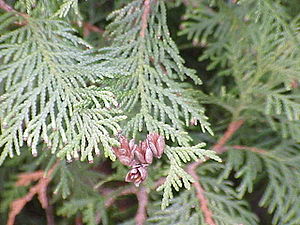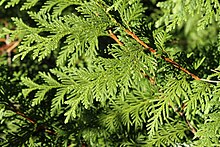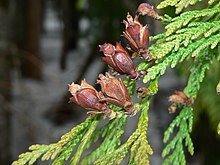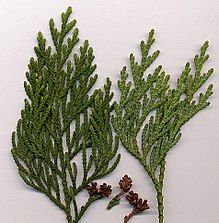Trees of life (genus)
| Trees of life | ||||||||||||
|---|---|---|---|---|---|---|---|---|---|---|---|---|

Branch with scaly leaves and ripe cones of the Occidental Arborvitae ( Thuja occidentalis ). |
||||||||||||
| Systematics | ||||||||||||
|
||||||||||||
| Scientific name | ||||||||||||
| Thuja | ||||||||||||
| L. |
Live trees or thuja ( Thuja ) are a genus in the family of cypress plants (Cupressaceae) within the order of the jaw-like (Pinales). There are two types in North America and three in Eastern Asia .
The species and their varieties , with the exception of the Sichuan tree of life ( Thuja sutchuenensis ), are generally used in culture; especially the occidental tree of life ( Thuja occidentalis ) is often used as a hedge plant.
description

Vegetative characteristics
Thuja species and their varieties grow as evergreen trees or shrubs . The tallest tree of the genus with 53 m is the "Quinault Lake Cedar" north of Quinault Lake in the Olympic Mountains in the US state of Washington . The trunk with a trunk diameter of 594 cm is hollow, yet the tree has a total volume of 500 m³.
The scale-shaped leaves are opposite in four rows on the branches. They differ in surface and edge leaves and occasionally have oil glands.
The seedlings have two seed leaves ( cotyledons ).
Generative characteristics
Thuja species are monoecious ( monoecious ), so there are male and female cones on one plant. The male cones usually have six to ten (in rare cases at least 4 at most 16) micro sporophylls . Each microsporophyll has two to four pollen sacs . The female cones are individually terminal on the branches. They have four to six pairs of seed scales , of which only the middle, larger two to three pairs are fertile . The small, egg-shaped, leathery cones ripen and open in the same year of pollination . Each fertile seed scale has one to three seeds. The seeds have two lateral, narrow wings.
Naming
The name "Lebensbaum" is ambiguous in German because of its broader meanings (e.g. also used for false cypresses ) and its use to denote the genus is to be regarded as a pure book name. In German usage, the term "Thuja" is far more common.
Systematics and distribution



The genus Thuja was established by Carl von Linné in 1753/4 . The generic name Thuja is derived from Thuya, an ancient Greek name for some evergreen, resinous tree species.
There are five species in the genus Thuja :
- Korean tree of life ( Thuja koraiensis Nakai , Syn . : Thuja odorata Doi ): It thrives at altitudes of 700 to 1800 meters in North Korea and in the Chinese province of Jilin only in Changbai Shan.
- Occidental arborvitae ( Thuja occidentalis L. ): It thrives at altitudes from 0 to 900 meters in northern North America in the Canadian provinces of Manitoba , Ontario , Québec , New Brunswick , Nova Scotia as well as on Prince Edward Island and in the US states of Minnesota , Michigan , Wisconsin , Illinois , Indiana , Ohio , Kentucky , Tennessee , North Carolina , Virginia , West Virginia , Maryland , Pennsylvania , New York , Connecticut , Massachusetts , Vermont , New Hampshire, and Maine .
- Giant arborvitae ( Thuja plicata Donn ex D.Don , Syn .: Thuja gigantea Nutt. ): It thrives at altitudes from 0 to 1500, rarely up to 2000 meters in western North America in the Canadian provinces of British Columbia and Alberta and in the US - States of Alaska , Montana , Idaho , Washington , Oregon and California .
- Japanese tree of life ( Thuja standishii (Gordon) Carriére , Syn .: Thuja japonica Maxim. , Thuja gigantea var. Japonica (Maxim.) Franch. & Savatier , Thujopsis standishii Gordon ): It only thrives on the mountains of the Japanese islands of Honshu and Shikoku .
- Sichuan tree of life ( Thuja sutchuenensis Franch. ): It thrives in the southeastern Daba Shan on limestone at altitudes of 1000 to 1500 (800 to 2100) meters. This endangered endemic occurs only in Chongqing in northeast Sichuan. It was not collected again after its first discovery in 1899 and was considered extinct in the wild until it was rediscovered in the same area 100 years later in 1999.
Another species, the oriental arborvitae or "Chinese thuja", which was previously assigned to the genus Thuja as Thuja orientalis L. , was placed in its own monotypical genus Platycladus under the name Platycladus orientalis (L.) Franco .
The individual species of the Thuja genus can be distinguished, among other things, by the aromatic scent of the grated, flaky leaves. Thuja koraiensis smells of almond cake, Thuja plicata (even without grinding) of pineapple, Thuja occidentalis of applesauce with cloves and the scent of Thuja standishii is reminiscent of lemon sweets.
Fossil evidence
The infrequent fossil representatives (or close relatives) of the genus Thuja are mostly referred to as "Thuites". Thuites branch remnants are already known from deposits of the Triassic. In the Tertiary , representatives of this genus were undoubtedly also at home in Europe. Four Thuites species have been described from the Eocene / Oligocene Baltic amber . Inclusions of parts of plants of this genus have also come down to us from the deposit of the presumably predominantly Miocene bitterfield amber .

use
Wood
Arborvitae have a light, red-brown heartwood . It's very durable and valuable. The North American species are used for forestry and are traded under the names "Red Cedar" ( Thuja plicata ) and "White Cedar" ( Thuja occidentalis ). The ingredients of tree of life wood can trigger allergies.
Since the post-war period, wooden shingles made from Canadian red cedar and later also from white cedar have been imported to Germany, which have better weather resistance than the local larch .
Naturopathy, toxicity
In naturopathy , thuja is used to treat warts . The solution is applied to a cosmetic pad and this is placed on the wart.
Branch tips and cones in particular are poisonous due to the thujone contained in the essential oil and can cause skin irritation in sensitive people, which is why it makes sense to wear gloves when cutting the plant. Ingested in sufficient quantities orally, the poison can be fatal.
Again and again there is fatal poisoning of grazing animals when hedge trimmings with thuja are disposed of on pastures.
Ornamental plant
The popularity of the arborvitae as an ornamental plant is based on the excellent cut tolerance. After a hedge has been created, a cut should be started at an early stage, whereby the cross-section of the hedge should be oriented towards a trapezoid. In the older state, a hedge can also be greatly shortened in height. In terms of width, this is only possible to a limited extent, as the tree of life is baked on the inside and does not grow back from woody twigs and branches. Because the plant is not native to Central Europe and has a very high water requirement, it has been banned in private gardens in some Austrian communities, at least temporarily. Some nature conservation organizations also emphasize that there are alternative hedge plants that are native, non-toxic and more beneficial for the animal world. In Germany, thuja hedges are increasingly suffering from drought as part of climate change, so that they increasingly have to be replaced by other ornamental plants.
literature
- Alan Mitchell: A Field Guide to the Trees of Britain and Northern Europe. Collins, London 1974, ISBN 0-00-212035-6 (English).
- Peter Schütt , Hans Joachim Schuck, Bernd Stimm (eds.): Lexicon of tree and shrub species. The standard work of forest botany. Morphology, pathology, ecology and systematics of important tree and shrub species . Nikol, Hamburg 2002, ISBN 3-933203-53-8 (reprint from 1992).
- Colin Tudge : The secret life of trees. Penguin, London 2006, ISBN 0-14-101293-5 .
- Christopher J. Earle: Thuja . In: The Gymnosperm Database . January 17, 2020 ( conifers.org [accessed March 26, 2020]).
Individual evidence
- ↑ Armin Jagel, Veit Dörken: Christmas green and cemetery conifers - determination of evergreen conifers without cones. In: Yearbook of the Bochum Botanical Association. Volume 4, 2013, pp. 208–307 ( botanik-bochum.de PDF 8.6 MB)
- ↑ a b c d e f g Christopher J. Earle: Thuja . In: The Gymnosperm Database . January 17, 2020 ( conifers.org [accessed March 26, 2020]).
- ↑ Armin Jagel, Thomas Stützel: Investigations on the morphology and morphogenesis of the seed cones of Platycladus orientalis (L.) Franco (= Thuja orientalis L.) and Microbiota decussata Kom. (Cupressaceae). In: Botanical yearbooks for systematics, plant history and plant geography. Leipzig Volume 123, 2001, pp. 337-404.
- ↑ Armin Jagel, Veit Martin Dörken: Morphology and morphogenesis of the seed cones of the Cupressaceae - part II: Cupressoideae. In: Bulletin of the Cupressus Conservation Project , Volume 4, Issue 2, 2015, pp. 51-78 ( PDF at cupressus.net ).
- ↑ Walther Gothan, Hermann Weyland: Textbook of Paläobotanik. Akademie-Verlag, Berlin 1954, DNB 451621867 .
- ↑ IA Dobruskina. Triassic Floras of Eurasia. In: Austrian Academy of Sciences Series of the Earth Science Commissions No. 10. New York 1994.
- ↑ Wolfgang Weitschat, Wilfried Wichard: Atlas of plants and animals in the Baltic amber. Pfeil, Munich 1998, ISBN 3-931516-45-8 .
- ^ Günter Krumbiegel, Brigitte Krumbiegel: The history, tendencies and the state of research on inclusions in Saxon (Bitterfeld) amber. In: Amber - views - opinions. Warsaw 2006.
- ↑ Haflinger herd in Thuringia: horses poisoned by green waste. In: Spiegel Online . May 11, 2014, accessed June 9, 2018 .
- ↑ From Portugal or Canada: Mainly cherry laurel. In: Frankfurter Allgemeine Zeitung , November 11, 2019.
